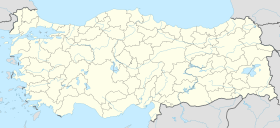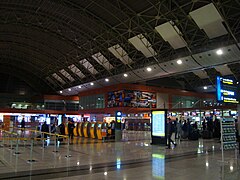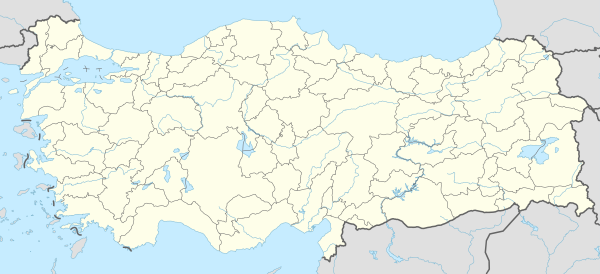Aéroport international Sabiha-Gökçen
| Aéroport international Sabiha Gökçen | ||||||||||

| ||||||||||
| Localisation | ||||||||||
|---|---|---|---|---|---|---|---|---|---|---|
| Pays | ||||||||||
| Ville | Istanbul | |||||||||
| Date d'ouverture | 2001 | |||||||||
| Coordonnées | 40° 53′ 55″ nord, 29° 18′ 33″ est | |||||||||
| Altitude | 95 m (311 ft) | |||||||||
| Informations aéronautiques | ||||||||||
| Code IATA | SAW | |||||||||
| Code OACI | LTFJ | |||||||||
| Type d'aéroport | Civil | |||||||||
| Gestionnaire | GMR Infra | |||||||||
| Site web aéroport | Consulter | |||||||||
|
||||||||||
| Géolocalisation sur la carte : Turquie
| ||||||||||
| modifier |
||||||||||
L'aéroport international Sabiha Gökçen (turc : Sabiha Gökçen Havalimanı prononcé [sɑ.'bi.hɑ gœk.'t͡ʃen]) est un aéroport de Turquie. Il est le deuxième aéroport de la plus grande ville du pays, Istanbul. Il est nommé en l'honneur de la fille adoptive d'Atatürk, l'aviatrice Sabiha Gökçen, première femme pilote de chasse au monde. Situé sur la rive asiatique du Bosphore dans le district de Pendik, il a été construit et inauguré en 2001[1] pour tenter de désengorger l'aéroport international Atatürk. Il a depuis connu une augmentation régulière du trafic, au point d'approcher du seuil de 4 millions de passagers en 2007. 2008 voit le début de travaux visant à porter la capacité à 25 millions de passagers par an. La barre des 10 millions de passagers a été passée en et celle des 20 millions de passagers en .

L'aéroport est principalement utilisé par des compagnies à bas prix européennes. Turkish Airlines effectue également quelques vols intérieurs turcs au départ de cet aéroport.
Nouveau terminal modifier
Avec le nouveau terminal, l'aéroport international Sabiha Gökçen a désormais une capacité d'accueil annuelle de 25 millions de passagers.
Achevé en 2009, ce terminal de 320 000 m2, inclut un hôtel de 128 chambres, 112 points check-in, 24 points Self Check-in (borne d'enregistrement), 20 points de contrôle de passeports, 4 500 m2 de magasins Duty free et 5 000 m2 d'espace cafés et restauration.
Le parking a une capacité de 4718 places de voitures et 72 places de bus sur quatre niveaux[2].
Fréquentation modifier
Voir la requête brute et les sources sur Wikidata.
| Année | Intérieur | Évolution % | International | Évolution % | Total | Évolution % |
|---|---|---|---|---|---|---|
| 2019[4] Jusqu'en |
10 407 326 | 6 340 492 | 16 747 818 | |||
| 2018[5] | 22 514 048 | 11 619 569 | 34 133 617 | |||
| 2017[6] | 21 075 833 | 10 310 205 | 31 386 038 | |||
| 2016[7] | 29 667 853 | 9 471 592 | 20 196 261 | |||
| 2015 | 18 535 463 | 9 576 975 | 28 112 438 | |||
| 2014 | 15 008 600 | 8 499 541 | 23 508 141 | |||
| 2013 | 11 928 074 | 6 593 688 | 18 521 762 | |||
| 2012 | 9 486 469 | 5 000 773 | 14 487 242 | |||
| 2011 | 8 555 793 | 4 193 437 | 12 749 230 | |||
| 2010 | 7 435 158 | 3 694 314 | 11 129 472 | |||
| 2009 | 4 547 673 | 2 092 285 | 6 639 958 | |||
| 2008 | 2 764 856 | 1 516 337 | 4 281 193 | |||
| 2007 | 2 528 549 | 1 191 946 | 3 720 495 | |||
| 2006 | 2 153 561 | 762 893 | 2 916 454 | |||
| 2005 | 559 824 | 459 922 | 1 019 746 | |||
| 2004 | 10 323 | 235 278 | 245 601 | |||
| 2003 | 2 826 | - | 154 346 | - | 157 172 | - |
Pour l'année en cours, les chiffres sont calculés à partir du mois de janvier et l'évolution du nombre de passagers est calculée par rapport au même mois de l'année précédente.
Compagnies aériennes et destinations modifier
Édité le 29/03/2020 Actualisé le 26/05/2023
Galerie modifier
-
Hall des départs.
-
Airbus A319 de la compagnie Azerbaijan Airlines.
-
Piste de l'aéroport.
Situation modifier
Liens externes modifier
Notes et références modifier
- « History And Establishment Of Heaş | HEAŞ », sur www.sgairport.com (consulté le )
- http://www.sabihagokcen.aero/new_terminal_
- « dhmi.gov.tr/haberler.aspx?Habe… »(Archive.org • Wikiwix • Archive.is • Google • Que faire ?).
- DHMI, Trafic de passagers (Juin 2018), dhmi.gov.tr
- DHMI, Trafic de passagers (2018), dhmi.gov.tr
- DHMI, Trafic de passagers (2017), dhmi.gov.tr
- DHMI, Trafic de passagers (2017), dhmi.gov.tr






